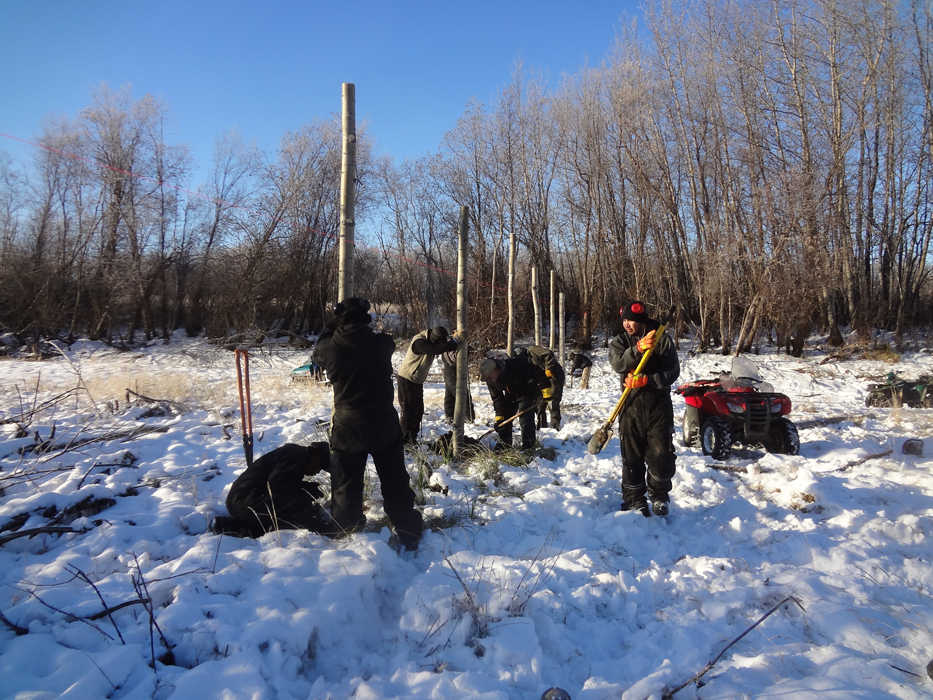Last weekend on a drive back from Anchorage, whizzing by the Alaska Wildlife Conservation Center at 57 miles per hour my daughter pointed out a strange looking moose on the side of the Seward Highway. “That isn’t a moose,” I explained, “that is a wood bison.”
And why are wood bison living in pens next to the Seward Highway? They are part of a reintroduction effort by the Alaska Department of Fish and Game (ADFG) and the Alaska Wildlife Conservation Center. The fate of these wood bison has been in the news lately as the U.S. Fish and Wildlife Service (USFWS) published a final rule in May 2014 that gives the green light to the reintroduction of a “non-essential experimental” population in interior Alaska scheduled for March 2015.
Wood bison are native to Alaska and were plentiful over a large portion of the state until their extirpation in the early 1900s. The reasons for their disappearance are not clearly known but probably related to overharvest and habitat loss.
Wildlife transplants are nothing new in Alaska. The reasons for transplanting animals generally fall into two categories. The first is to provide human related benefits such as recreational hunting, economic gain, or an additional food supply. The second is related to species recovery in their historic range.
Kodiak Island is a dramatic example of the first category. With the exception of the brown bear, the island had very few native mammals as a result of its glacial history. Sitka black-tailed deer, mountain goats, Roosevelt elk, reindeer, beaver, red squirrel, snowshoe hare and American marten have all been introduced within the last century, none of which are native to Kodiak.
Wood bison fall into the second category, as do caribou on the Kenai Peninsula. Historically, caribou were abundant on the Kenai Peninsula, but were completely wiped out in the early 1900s. The cause of their extirpation is unclear but likely due to a combination of human-caused fires that destroyed winter habitat and market hunting in the late 1800s. The last 13 caribou on the peninsula were shot in 1912 near Ptarmigan Head in the Caribou Hills.
A joint USFWS-ADFG plan was hatched to restore caribou to the peninsula after a 1952 USFWS assessment concluded that range conditions could again support caribou. In May 1965, 15 caribou from the Nelchina herd were released on the former Kenai National Moose Range between Chickaloon River and Mystery Creek. This seed population became the Kenai Mountain herd which now ranges over Chickaloon River, Big Indian Creek and Resurrection Creek.
To augment that first transplant effort, another 29 caribou from the Nelchina herd were released at Watson Lake near Sterling in April 1966. These caribou became the Kenai Lowlands herd that ranges in and around Sterling, Kenai and Soldotna. Although the 1965-66 introductions were successful, the two principal historic caribou ranges on the Kenai, the Caribou Hills and Skilak-Tustumena Benchlands, were still caribou-free.
So in April 1985, 28 caribou from the Nelchina herd were released near Glacier Creek. In April 1986, 18 caribou each were released at both Emma and Green Lakes in the Kenai National Wildlife Refuge, and 16 caribou at Caribou Lake in the Caribou Hills. From this second series of transplants emerged the Killey River, Twin Lakes and Fox River herds. The Twin Lakes herd subsequently merged with the Killey River herd in 2002.
Although caribou didn’t re-occupy Caribou Hills, caribou reintroduction on the Kenai Peninsula is considered a success. The Killey River, Kenai Mountain and Fox River herds provide hunting opportunities, and the Kenai Lowland herd provides wildlife viewing opportunities for residents and tourists during several months of the year.
As you can probably tell by looking outside, this winter is quite a departure from the norm. In fact, for the last two winters, we have seen very unusual warm temperatures and little snowfall. This recent spike is part of a longer warming and drying trend that began in earnest in the late 1970s. Average January temperatures at the Kenai Airport have increased 7 degrees since 1977!
Climate envelope models, mirroring field data, forecast dramatic vegetation changes on the peninsula. Spruce bark beetle-killed forests on the southern peninsula show strong signals of grassland conversion. Alpine tundra in the Kenai Mountains show strong signals of upslope forest (white spruce and hemlock) and shrub conversion.
Perhaps we should begin thinking of adding another category to our list of reasons for transplanting animals. What about introducing species adapted to a warmer climate or “keystone” species that can help shape a changing ecosystem?
For example, although there is no evidence that wood bison ever occupied the Kenai, it wasn’t so long ago that steppe bison roamed Caribou Hills (see previous Refuge Notebooks articles by Dawn Magness and Dick Reger). If ecosystems continue changing as predicted, bison introduction to the peninsula might be up for discussion. But don’t hold your breath as a number of legal issues would need addressing to introduce new species to the Kenai Refuge, especially within Congressionally-designated wilderness.
Time will tell if climate trajectories will continue as predicted and whether our views on managing wildlife populations change accordingly. But for now it seems that the wood bison will once again roam free within a small portion of their historic range.
Nathan Olson is the wildlife biologist-pilot at Kenai National Wildlife Refuge. Find more information about the refuge at http://www.fws.gov/refuge/kenai/ or http://www.facebook.com/kenainationalwildliferefuge.

